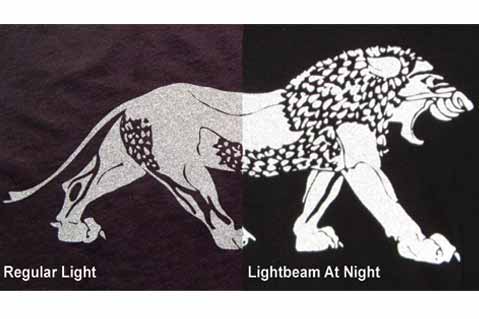Strategy October 03, 2016
Master Reflective Inks
Reflective inks can be useful in workwear, and stylish on fashionwear.
Reflective ink can help keep people working in dangerous situations safe, and it can also be fashionable, adding interest to an otherwise standard design. While printing with reflective ink can be profitable, printing successfully does require some special techniques. Screen printers using reflective ink will have the biggest chance of success if they keep these tips top of mind.

Always stir the ink thoroughly before printing. Reflective inks are made up of small reflective glass beads and a carrier base. The base is thin, and this allows the beads to settle. Stirring the ink distributes the beads more evenly throughout the carrier before the design is printed.
One flood coat, one squeegee print. The reflectivity in the ink comes from the reflective particles, not the base. One flood coat and one squeegee print will generally yield the most reflectivity. Printing in this manner will allow the base coat to settle into the fabric, leaving the reflective particles on top where they can catch the light. Multiple print strokes will lay down too much of the base and the reflective beads won’t sit on top of the fabric evenly or catch the light properly.
Follow recommendations for mesh counts. Reflective particle sizes may differ and may require different mesh counts to be printed properly. Using a mesh count that’s too fine will strain the reflective particles from the carrier base. Less reflective beads mean less reflectivity. It’ll also result in a mesh that’s clogged with costly reflective beads. The beads belong on the shirt, not on the mesh.
Use an underbase when printing dark colors. If extra opacity is needed, or the reflective ink will be printed on a dark-colored garment, a white underbase can be printed first. The thing to remember here is that there will be a loss of some reflectivity because the base won’t soak completely into the fabric that’s being printed.
Use what’s necessary to make the beads stick. Some brands of reflective ink may require the use of a catalyst, adhesion promoter or coupler. The purpose of all these things is to ensure the reflective beads stay on the garment where they belong. Follow all manufacturer recommendations when using these products.
Printing on specialty fabrics, like nylon. You can print some brands of reflective ink on nylon. When printing on nylon, use a coupler with the reflective ink. This will help the ink bond to the substrate. You may also print the reflective ink over a base color. Note, printing over a base color may cause a reduction in the ink reflectivity.
Always test wash your first print. Before starting any large print job, always test wash your first print to make sure adhesion and durability meet the required standards. The time to find out if there are problems is before you’ve done a huge batch of shirts, not afterward when dissatisfied customers bring the garments back to you.
Now Watch: Reflective and Screen Print Transfers
Like the look of reflective screen print, but don’t want to do the print yourself? In those cases, reflective transfers combined with screen-printed transfers may be the perfect option. This video from Stahls’ Transfer Express (asi/91804) shows how to combine the two types of transfers for a screen-printed look with reflective qualities. Watch the video here.

